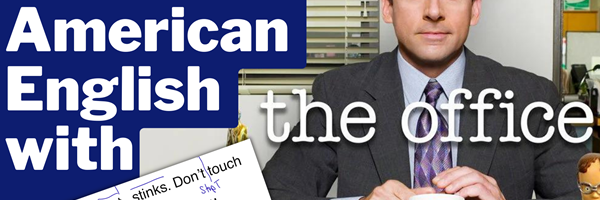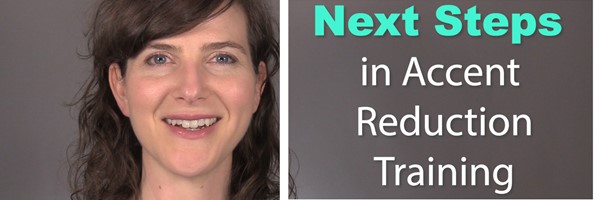(Video Transcript)
To really improve your English pronunciation and listening skills, you need to listen to Americans speaking English, and then imitate what you hear. In this video, I’ll play a short clip of a scripted conversation from the show Parks and Recreation. Then I’ll complete an in-depth analysis of the pronunciation and vocabulary. Listen along and take notes as I go - I’ll be discussing all areas of American English pronunciation, from pronunciation of vowels and consonants, to syllable and word stress, linking between words, and vocabulary.
First, you’ll hear the conversation in its entirety, then I’ll complete the analysis.
First, the conversation. Now for the analysis.
Sentence Analysis
Ok! Brainstorm! How do we make this park happen?
Let’s first talk about stress. Which words do you hear are stressed the most? I hear, Ok, BRAINstorm. And then she says the next part in one thought group, and she starts by stressing the first part of the question HOW DO, and her pitch and stress go down at the end. This question is considered a WH-question, even though the word How starts with an H, and the pitch with WH-questions goes down at the end. WH-questions are questions that start with the WH words, like Who, What, Where, When, and Why. The word How is grouped together with the WH words.
Now listen to the diphthong AY /eɪ/ in OK, I hear that she shortens the diphthong. She shortens it to /e/, OK, because she is excited and talking very quickly.
She does the same thing to the diphthong OW /aʊ/ in How - she shortens it to just /a/, and then do is reduced to duh, which is a common reduction in American English. This becomes, ha-duh-we (how do we), ha-duh-we (how do we) as she links these words together.
Then she links make this and park happen. She doesn’t fully release the K, which is common when one word ends in a stop consonant and the next word begins with a consonant, which is one of the rules to consonant to consonant linking. Native speakers tend to hold the stop consonant. She releases the K just a bit but not fully - it’s not make this park happen - she links the words together.
Now for vocabulary. She uses the word brainstorm. Maybe you’ve heard this word before, but brainstorm means to have an informal group discussion to create ideas and ways of solving problems. So these characters are brainstorming, or coming up with ways to gather the money for this park.
Let’s go to City Council directly and ask them to put up the money.
I hear the words GO TO, diRECTLy, ASK, MONey as having the stress. Goduh (go to). Goduh (go to). He changes the T in to to the flap T, and reduces the vowel in to to the schwa /ə/, which is a common function word reduction in English. Then another flap in city, city. He drops the D in and and links the words together, an-ask (and ask), an-ask (and ask). Then he drops the TH in them, ask-em (ask them), ask-em (ask them), an-ask-em (and ask them), both of which are common word reductions in English. It’s common to drop the initial H and TH in pronouns, like him, her, and them, in connected speech. So the word them becomes em, ask-em (ask them), ask-em (ask them).
So he says, an-ask-em duh-pud-up (and ask them to put up). I hear a flap T in to, and a reduction of the vowel to the schwa /ə/, then another flap T in put. An-ask-em-duh-pud-up the money (and ask them to put up the money).
And for vocabulary - he uses the phrasal verb to put up the money - to put up something. This phrasal verb has several meanings, but here he uses it to mean, to provide a large amount of money for something.
No. Parks are not a priority. I need more firepower. I need bigger guns.
For the stressed syllables, I hear NOT A, i NEED, more FIREpower. I NEED bigger guns. Then she uses a flap T to link not and a, and a is reduced to the schwa, UH /ə/. Nodda (not a), nodda (not a). Then she uses an unreleased D to link need more. Need more, the D is there, but the sound is not released - the tongue stays up at the roof of the mouth. And again with need bigger, she uses an unreleased D to link these words together. Need bigger, need bigger.
You know what I need to do? Form a committee! Right?
Her intonation goes up at the end because this is a yes/no question, and typically yes/no questions go up in pitch. Then she uses a flap T in the word what to link it to the next word, I. Whad- I (what I). Whad-I (what I). Then I don’t hear a strong D in need - I think she either uses an unreleased D or drops the D altogether, when she links it to the word to. And she reduces the vowel in to, to the schwa, /ə/ UH, another common reduction of function words. A is reduced to UH /ə/, and she links form and uh together, formma (form a), formma (form a). And then uses a true T at the end of right. And her pitch goes up at the end of right, because that’s a yes/no question.
Yeah, that could work.
So I hear YEAH, that could WORK as the words that receive the most stress. He uses a glottal stop here for the T in that as he links it to the K in could. That could. That could. And he drops the final D in could, so it sounds like K’work (could work), K’work (could work).
Yeah, cause committees are power, and committees make things happen.
I hear, YEAH, cause committees are POWer, and committees make things HAPpen as the stressed syllables. She reduces cause to cuz, to the schwa vowel. Cuz. And she also reduces are to ER /ɚ/, and and to N, all three of these are common word reductions in American English. Then she links the K in make to the TH in things by reducing the release of the K, make things, make things, another rule of consonant to consonant linking.
Committees are the lifeblood of our Democratic system.
I hear, commITtees are the LIFEblood of our demoCRAtic SYStem, as the stressed syllables, and LIFEblood has the most stress. The LIFEblood. Here she pronounces the word the with the EE /i/ vowel, the LIFEblood, and then places a lot of stress on LIFEblood, LIFEblood, definitely the most important word of this thought group. Then she reduces our to /ɑɹ/, another common reduction of function words. And the linking between Democratic and system is another example of reduced release of the stop consonant K.
Now for vocabulary - she uses the word lifeblood. This might be a new word for most of you, and you can probably guess its meaning based on the context of the sentence. But lifeblood is a noun that means something that is absolutely necessary to the strength and energy of something.
That’s really good - write that down.
I hear, that’s REALly good - WRITE that Down as the stress. She reduces the TH in that’s, or she says the TH really quickly, so her tongue tip is most likely not fully out of the mouth, which can happen with the voiced TH. Then she uses a glottal stop T when she links write, that, down. Write that down.
Yep.
So says the word yep, which is an informal way of saying yes, and he pronounces it almost like yap. The pronunciation of yep is more common.
From time to time when I think of an eloquent saying or a phrase, I have Tom write it down.
For the stressed syllables, I hear, from TIME to TIME when I think of an ELoquent SAYing or a PHRAse, I have Tom write it DOWn. Time to time. Here she reduces the OO /u/ vowel in to to the schwa, /ə/ UH, which is a common reduction in American English. Tuh, time tuh time (time to time). Then she connects when and I, as whennni (when I), whenni (when I). Think of an, so for this phrase, the links think of like thin-kof, thin-kof, and she splits the final consonants of think, so that the K begins the next word, of, which is a common way that native speakers will link two words together when one word ends in two consonants and the next word begins with a vowel. And then she reduces an to N /n/, another common reduction. Thinkofn (think of an).
Eloquent saying. Here she uses a glottal stop T or an unreleased T in eloquent to link to the next word saying, because saying begins with a consonant. And she reduces the word or to ER /ɚ/ and a to UH /ə/, more common function word reductions, and links them together with ER, erruh (or a), erruh (or a).
Write it down. Here she uses a flap T in write, but a glottal stop T in it. Write it down. Write it down.
Now for vocabulary - she uses the word eloquent, an eloquent saying or phrase. The word eloquent is a positive adjective to describe when something is well-spoken, or expressed gracefully or effectively.
He’s collecting them for my memoirs.
He’s coLECTing them for my MEMoirs as the stressed syllables. Memoir is a French word, and it describes a book that a person can write about their life experiences, similar to an autobiography. For reduces to fer /fɚ/, which is another common function word reduction in American English.
Here’s Leslie’s quote from Wednesday.
I hear the words HERE’s Leslie’s QUOTE from WEDnesday as the stressed syllables, and HERE's receives the most stress. He uses a glottal T as he links quote to from, and then he could link from to Wednesday with a continuous M sound, but he takes a quick break in the voicing between these words.
Thanks so much for watching! And I'd love to hear from you - contact me to learn how we can work together to perfect your American English pronunciation!



